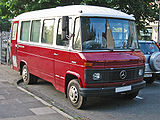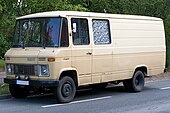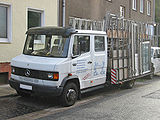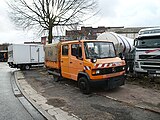Mercedes-Benz T 2
| Mercedes-Benz T2 | |
|---|---|
| Manufacturer: | Daimler Benz |
| Production period: | 1967-1996 |
| Previous model: | L 319 |
| Successor: | Vario |
T 2 denotes a series of vans that was built by Daimler-Benz from 1967 to 1996 . The T 2 is also known as the Düsseldorfer Transporter (hence also called "DüDo" by enthusiasts and collectors), as it was built at the Düsseldorf plant until 1991/1992 ; The transporter was only given the designation T 2 later after the introduction of the smaller T 1 . The T 2 was then produced in the Ludwigsfelde plant , where the IFA W50 and L60 had been built until 1990 . Since the second generation, the model has also been assembled in the Spanish assembly plant in Alcobendas . With the generation change to the third generation, the T 2 series was given the name Vario .
Mercedes-Benz T 2 (old), type: 309, 310, 313
| T2 alt | |
|---|---|

Mercedes-Benz L 407 D 35 flatbed truck, (built 9 / 1977–9 / 1981) with double cab |
|
| Production period: | 1967-1986 |
| Designs: | Panel vans , flatbed trucks , minibuses |
| Engines: |
Otto engines : 2.0–2.3 liters (59–64 kW) Diesel engines : 2.0–5.6 liters (40–96 kW) |
| Length: | 5065-6996 mm |
| Width: | 2100-2405 mm |
| Height: | 2385-2750 mm |
| Wheelbase: | 2950-4100 mm |
| Perm. Total weight: | 3.49-6.79 t |
The T 2 came on the market in 1967 as the successor to the L 319 large van series . The T 2 was available as a panel van , flatbed truck (also as a double cabin ; often referred to as a DoKa) and minibus . From 1977 the body for panel vans and station wagons / minibuses was also available in a larger width, the so-called "wide mouth". In the same year, the series underwent its first facelift, which made its appearance recognizable by the more modern rear lights and rubber-reinforced bumpers. Inside, a new dashboard and crank windows instead of the sliding windows that were common up to that point made life easier for the driver. The triangular windows in the door were also designed as hinged windows. There were also new control levers and handles as well as a steering wheel with a non-slip coating .
In 1981 there was a second facelift ; a new, black plastic grille and a wide plastic bumper. At the same time, the Düsseldorf plant is equipping the large vans with a new interior trim. In addition, the ignition key was now generally used to start. Up to now, an ignition key in the form of a cylindrical metal pin usually had to be inserted to start the engine. This established electrical contact. Until 1981, the parking light and the low beam were also switched on in two stages with the pin key. With the direct injection engine, a start button had to be pressed to start the engine, as the key variant was only available as an option.
At the beginning of the 1970s, the T 2 was also available for a few years under the brand name Hanomag-Henschel . Daimler-Benz had bought up Hanomag-Henschel's truck division some time beforehand. Headlights and radiator grille differed in appearance from the Mercedes-Benz counterpart, otherwise the vehicles were identical and were manufactured together with the Mercedes-Benz T 2 in Düsseldorf.
All variants of the T 2 were widespread; They were used as delivery vans, light construction site vehicles , fire and police vehicles , ambulances, parcel delivery vehicles for the German Federal Post Office (mostly with sliding doors on the driver and passenger side) and for special applications, for example for the German armed forces . They achieved fame under the nickname "Berliner Wanne" as the (often dented) emergency vehicles of the Berlin police , which their officers used to use. a. promoted to demonstrations and riots. Furthermore, the T 2 series was used as an NBC, radiation and respiratory protection vehicle in the long version for the fire brigades of the state of Rhineland-Palatinate; To this day, the Trier professional fire brigade relies on a T-2 transporter.
The production of box vans and flatbed trucks in Germany ended after around 540,000 units in 1986, but the bus continued to be produced for a while. In today's streetscape you can often still find the first generation as a residential bus .
Some of these DüDos of the model series 406 D and 407 D were equipped with the inline four-cylinder diesel engine OM 615 or OM 616, which was already known from the W 115 series (the so-called "Stroke Eight", since it was produced from 1968) was. The most popular drive, however, was the most powerful four-cylinder diesel engine from the W 115 (model 240 D), which developed 48 kW (65 hp) or later 53 kW (72 hp). Daimler-Benz also used the same engine in the smaller T 1 series . Most of the T-2 transporters (408 D, 508 D, 608 D, O 309) were ordered with the in-line four-cylinder diesel engine type OM 314 with 3780 cm³, which has a peak output of 59 kW (80 hp) or a few years later brought 63 kW (85 hp). Furthermore, there was a 95 kW (130 PS) engine ( OM 352 ) for the six-ton chassis (613 D) in the last few years of construction .
There were also variants with gasoline engines throughout the construction period . The corresponding sales names for this were initially 408 and changed over the years to 409 and 410 (bus version O 309). Various variants of the M 121, M 115 and M 102 series have been installed as engines over the years.
During the construction period - depending on the model - up to three different rear axle ratios were available.
Engines
| model | Identification code | cylinder | Displacement | power | Torque | Years of construction |
|---|---|---|---|---|---|---|
| with diesel engine: | ||||||
| 406 D | OM 621 VIII | Row 4 | 1988 cc | 40 kW (55 PS) at 4350 rpm | 113 Nm at 2400 rpm | 1967 |
| 406 D | OM 615 D 22 | Row 4 | 2197 cc | 44 kW (60 PS) at 4200 rpm | 126 Nm at 2400 rpm | 1968-1974 |
| 407 D | OM 616 | Row 4 | 2404 cc | 48 kW (65 PS) at 4200 rpm | 137 Nm at 2400 rpm | 1974-1982 |
| 407 D | Row 4 | 2399 cc | 53 kW (72 PS) at 4400 rpm | 137 Nm at 2400 rpm | 1982-1986 | |
| 408 D / 508 D / 608 D | OM 314 | Row 4 | 3758 cc | 63 kW (85 PS) at 2800 rpm 59 kW (80 PS) at 2800 rpm |
235 Nm at 1800 rpm 228 Nm at 1800 rpm |
1968–1986 (408 D until about 1972) |
| 613 D | OM 352 | Row 6 | 5675 cc | 96 kW (130 PS) at 2800 rpm | 363 Nm at 2000 rpm | 1977-1986 |
| with gasoline engine: | ||||||
| 408 | M 121 | Row 4 | 1988 cc | 59 kW (80 PS) at 5000 rpm | 1967 | |
| 408 | M 115 V 22 | Row 4 | 2197 cc | 63 kW (85 PS) at 5000 rpm | 1968-1974 | |
| 409 | M 115 V 23 | Row 4 | 2307 cc | 66 kW (90 PS) at 4800 rpm | 160 Nm at 2000 rpm | 1974-1982 |
| 410 | M 102 V 23 | Row 4 | 2299 cc | 70 kW (95 PS) at 5200 rpm | 170 Nm at 2500 rpm | 1982-1986 |
gallery
Mercedes-Benz T 2 (new), type: 667, 668, 669, 670
| T2 new | |
|---|---|
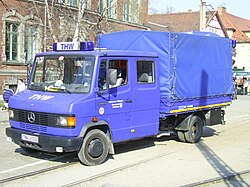
|
|
| Production period: | 1986-1996 |
| Designs: | Panel vans , flatbed trucks , minibuses |
| Engines: |
Otto engine : 2.3 liters (77 kW) Diesel engines : 2.3-4.0 liters (58-103 kW) |
| Length: | 5450-7210 mm |
| Width: | 2180 mm |
| Height: | 2560-2720 mm |
| Wheelbase: | 3150-4250 mm |
| Perm. Total weight: | 3.49-7.50 t |
The second, completely newly developed generation of the T 2 came on the market in 1986 and was built until 1996. The hood had become a bit longer, the design overall more angular. Although the term “Vario” was only introduced in the third generation, it is often used in “normal language” - due to the almost identical appearance - also applied to these vehicles. The T 2 (new) was primarily equipped with diesel engines. The following diesel variants were available: 507 D, 508 D, 511 D, 609 D, O 609 D, 611 D, O 611 D, O 614 D, 709 D, 711 D, 714 D, 809 D, 811 D, 814 D and 814 DA (A stands for charged / turbo). The Mercedes-Benz 510 model was the only T 2 (new) with a petrol engine, the M 102. In times of high diesel prices, the 510 enjoyed increasing popularity as it was suitable for conversion to LPG (liquid gas). In 1991/1992, production of the T 2 was relocated from Düsseldorf to the Ludwigsfelde plant, where the successor model Vario also rolled off the assembly line from 1996 (until 2013).
Engines
| Sales description | Cubic capacity cm 3 |
Bore × stroke mm |
Motor series | Power kW (PS) in min -1 |
Torque Nm at min -1 |
construction time | Injection system |
|---|---|---|---|---|---|---|---|
| Line four-cylinder - petrol engine | |||||||
| 510 | 2299 | ø95.5 × 80.25 | M 102 | 70 (95) 77 (105) 5100 |
185 2200-2700 |
1986-1996 | Carburetor |
| Line four-cylinder - diesel engine | |||||||
| 507 D | 2399 | ø90.9 × 92.4 | OM 616 | 53 (72) 4400. |
137 2400 |
1986-1989 |
In-line injection pump line nozzle holder |
| 508 D | 2299 | ø89 × 92.4 | OM 601 D23 | 58 (79) 3800 |
157 2000-2800 |
1989-1996 | |
| 609 D, 709 D, 809 D | 3972 | ø97.5 × 133 | OM 364 | 66 (90) 2800 |
266 1400-2200 |
1986-1992 | |
| 63 (86) 2800 Euro-1 |
254 1400-2200 |
1992-1996 | |||||
| 711 D, 811 D |
OM 364 A (charging) |
85 (115) 2600 |
378 1400-1500 |
1986-1992 | |||
| 77 (105) 2600 Euro-1 |
358 1400-1500 |
1992-1996 | |||||
| 611 D, 711 D, 811 D |
OM 364 LA (charge air cooling, supercharging) |
77 (105) 2600 Euro-2 |
345 1200-1500 |
1994-1996 | |||
| 814 D, 814 DA (4 × 4) | 100 (136) 2600 |
408 1400-1600 |
1987-1992 | ||||
| 100 (136) 2600 Euro-1 |
428 1300-1800 |
1991-1994 | |||||
| 614 D, 714 D, 814 D, 814 DA (4 × 4) | 103 (140) 2600 Euro-2 |
500 1200-1500 |
1994-1996 | ||||
gallery
MB 507 medical troop car , note the higher doors of the van
Web links
Individual evidence
- ↑ History of the Mercedes-Benz Transporter
- ↑ Mercedes-Benz Espana, SA ( Memento from December 20, 2009 in the Internet Archive )
- ^ Axel Gröblinghoff: Eifel trucks - commercial vehicles from Eifel and the surrounding area 1940-2000 . Hürtgenwald 2009.
- ^ Axel Gröblinghoff: Eifel trucks - commercial vehicles from Eifel and the surrounding area 1940-2000 . Hürtgenwald 2009.
| Vehicle class | 1920s | 1930s | 1940s | ||||||||||||||||
| 6th | 7th | 8th | 9 | 0 | 1 | 2 | 3 | 4th | 5 | 6th | 7th | 8th | 9 | 0 | 1 | 2 | 3 | 4th | |
| Compact class | W 15 (type 170) | ||||||||||||||||||
| W 23 (type 130) | |||||||||||||||||||
| W 30 (type 150) | |||||||||||||||||||
| W 28 (type 170 H) | |||||||||||||||||||
| Middle class | W 02 (type Stuttgart 200) | W 136 / W 149 (types 170 V / 200 V) | |||||||||||||||||
| W 11 (type Stuttgart 260) | W 143 (type 230 n) | ||||||||||||||||||
| W 21 (type 200/230) | W 153 (type 230) | ||||||||||||||||||
| W 138 (type 260 D) | |||||||||||||||||||
| upper middle class | W 03 / W 04 / W 05 (types 300/320/350) | W 18 (type 290) | |||||||||||||||||
| W 10 / W 19 (types 350/370/380) | W 142 (type 320) | ||||||||||||||||||
| W 22 | |||||||||||||||||||
| Upper class | Type 400 & Type 630 | W 24 / W 29 / W 129 (types 500 K / 540 K / 580 K) | |||||||||||||||||
| W 08 (type Nürburg 460/460 K / 500 / type 500 N) | |||||||||||||||||||
| W 07 / W 150 (types 770/770 K) | |||||||||||||||||||
| Sports car | Model K | ||||||||||||||||||
| W 06 (type S / SS / SSK / SSKL) | W 24 / W 29 / W 129 | ||||||||||||||||||
| Off-road vehicle | W 103 (type G1) | W 31 (type G4) | |||||||||||||||||
| W 133 III (type 170 VG) / W 139 (type 170 VL) / W 152 (type G5) | |||||||||||||||||||
| Vans | L 3/4 | L 1000 Express | L 301 | ||||||||||||||||
| L 300 | |||||||||||||||||||



